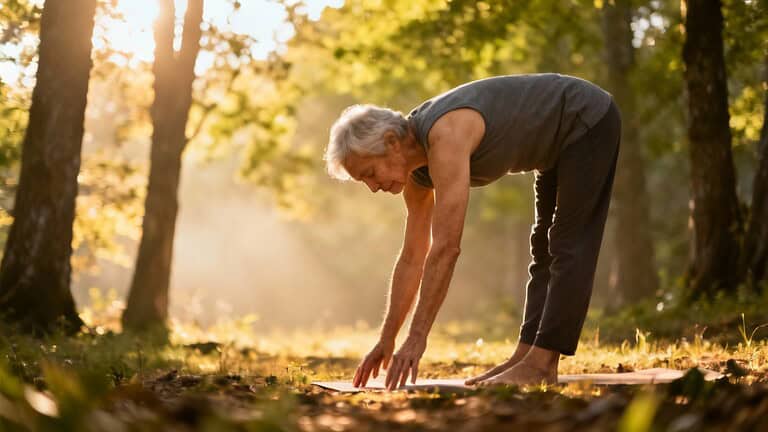What if the stiffness you feel in your body after 50 isn’t just about aging? What if it’s actually your body’s way of protecting you from decades of unprocessed stress and emotional tension?
Most people accept tight hamstrings and limited flexibility as inevitable parts of getting older, but there’s a deeper story waiting to be told—one that could transform how you move through life.
Reclaim Your Flexibility and What That Really Means After 50
Flexibility after 50 isn’t about doing the splits or showing off in a yoga class. It’s about something far more vital: how easily you move through life physically, emotionally, and mentally.
As we age, we often confuse stiffness with inevitability, telling ourselves “I’m just getting old.” But what if your lack of flexibility isn’t because you’re aging, but because your body has been stuck in protection mode for decades?
Your hamstrings are part of a deeper network called the myofascial backline. When they tighten, it’s often your nervous system trying to shield you not just from injury, but from vulnerability, stress, and emotion. The stiffness you feel isn’t just physical—it’s existential tension silently layered in your tissues.
By practicing the daily forward fold gently with breath and awareness, you begin to unwind years of unconscious holding.
Something remarkable happens: you don’t just become more flexible in your body; you become more flexible in your life.
Decisions feel lighter, you react less and respond more, and you feel more present in your relationships. You stop gripping so tightly to control and start trusting the flow again.
Goodbye to Hidden Stress and Stored Tension
Let’s talk about stress—the kind that lives in your body, not just your mind. You may think stress leaves when the moment passes, but after 50, most of us are carrying decades of unprocessed tension. This doesn’t just disappear; it gets stored deep in the tissues, especially in your hamstrings.
When you sit for years, hold your breath through hard times, or push through life without pause, your nervous system learns one thing: survival through contraction.
The muscles at the back of your body become your body’s armor, tightening not just from inactivity but from the emotional weight you’ve never had time to release.
This daily forward fold isn’t just a stretch—it’s a conversation with your nervous system gently saying, “You’re safe now. You can let go.” When you combine breath, touch, and mindful movement, something powerful happens.
Stored stress begins to melt. You may feel subtle tremors, heat, or even emotion rising to the surface. That’s not weakness; that’s release. That’s healing.
Better Sleep, Better Mood, Better Decisions
After 50, it’s easy to accept poor sleep, low energy, or emotional swings as just part of getting older. But what if your restless nights and reactive moods aren’t about age, but about a nervous system stuck in survival mode?
When your body holds onto stress, it doesn’t shut off at bedtime. It hums beneath the surface, quietly telling your brain, “Stay alert. Stay tense. Don’t relax.” This is why you wake up tired, why small things feel overwhelming, and why making decisions—big or small—feels heavier than it should.
The simple act of folding forward with awareness activates your ventral vagus nerve, the part of your nervous system responsible for rest, digestion, and calm connection. Combined with deep rhythmic breathing and intentional touch, this practice sends a signal of safety to your entire body.
When your body feels safe, your brain no longer has to stay on high alert. You fall asleep easier, stay asleep longer, wake up clearer, and your moods stabilize. Most importantly, you start making decisions not from fear or urgency, but from a grounded sense of inner clarity.
Prevent Falls, Improve Posture, Walk Tall Again
One of the biggest threats to independence isn’t disease—it’s falling. A simple trip or slip can change everything. But most people don’t realize the root of stability isn’t just balance; it’s body awareness. And that awareness begins in the back of your body, especially your hamstrings.
As we age, we tend to lose our connection to the ground. Our posture caves, our steps become shorter, and we stop trusting our own movements. But what if this gradual loss of confidence in your body wasn’t inevitable? What if it was reversible?
This daily forward fold reconnects you with something vital: your body’s internal map. With conscious breathing, gentle touch, and mindful descent, you activate proprioception—your body’s ability to sense itself in space. You begin to feel where you are again, reawakening the neural pathways between your feet, legs, spine, and brain.
Slowly, your posture begins to correct itself not through force, but through reconnection. You’ll start standing taller without trying, walk with more grace, and most importantly, regain trust in your movements. This isn’t about becoming athletic; it’s about staying sovereign in your body so you can keep living life on your own terms.
Awaken Your Creative Energy and Emotional Vitality
Something beautiful happens when your body stops bracing for life and starts opening to it. By the time we reach our 50s, many of us have unknowingly shut down parts of ourselves just to cope. We’ve been strong for others, pushed through pain, and survived. But in the process, we often lose touch with our creative spark, emotional softness, and sense of flow.
Here’s the truth: that part of you isn’t gone. It’s just been buried under tension, responsibility, and years of holding it all together. This daily forward fold, done with intention, does more than stretch your muscles—it unlocks emotional memory stored in your fascia, especially along the backline.
As you breathe and fold, you might feel warmth rise, a lump in your throat, or a sudden wave of inspiration. That’s not random; that’s your energy coming back online. When you release physical rigidity, you make space for creative flow to return. You feel more inspired, more emotionally available, and start smiling more easily.
How to Do the Forward Fold Safely and Powerfully
This isn’t about pushing your body; it’s about inviting it to remember. Here’s how to practice safely:
- Start by standing with your feet hip-width apart, knees slightly bent, and weight evenly balanced across your soles
- Close your eyes for a moment and feel your connection to the ground
- Take a slow, deep inhale through your nose for a count of six, letting your ribs expand
- Exhale for a count of eight, letting your body soften
- Place your hands gently at the tops of your thighs
- As you begin to fold forward, keep your spine long and your knees soft
- Slide your hands down the back of your legs with steady, conscious touch
- Go only as far as your breath stays calm and your body feels safe
- Don’t aim for the floor; aim for sensation, not destination
- Once you reach your edge, stay there and breathe—three deep cycles
- On each exhale, invite just a little more surrender
- Remain in the fold for one to two minutes or less if needed
- When you rise, do so slowly, vertebra by vertebra, staying connected to sensation
This isn’t a workout; it’s a ritual, a daily ceremony of reconnection. Done regularly, it becomes a message to your nervous system: you don’t have to brace anymore; it’s safe to flow. Even one minute a day can create change, but the magic is in consistency: gentle, attuned, and present.
Who Shouldn’t Do This Practice
While this fold is gentle, it’s not for everyone. If you’ve had recent spinal surgery, a herniated disc, or severe sciatica, consult your doctor or physical therapist before trying it.
Avoid deep forward folds if you have osteoporosis with spinal compression risk or if bending forward causes sharp pain.
This practice is about listening, not forcing. If your body says not yet, honor that wisdom. There are always other paths to healing.
The goal isn’t to prove anything; it’s to create space for safety, flow, and long-term freedom. Modify, support yourself, and when in doubt, always prioritize gentleness over ambition.
This Isn’t Just a Stretch—It’s a Return to Yourself
If you’ve made it this far, let me say this clearly: you’re not behind; you’re just on the edge of a beautiful return.
This simple daily fold may look like a stretch, but what it really offers is a pathway back to yourself—to the version of you that moves with ease, breathes without bracing, and trusts their body rather than fears it.
Too often after 50, the world tells us to shrink, to settle, to manage decline. But your body has a different message: “I remember how to open; I just needed you to ask.”
Every time you fold forward with care, you’re not just improving flexibility—you’re dissolving decades of tension, rewriting old stories etched into your tissues, and telling your nervous system it’s safe to live fully now.
What happens when you do this every day? You sleep better, walk taller, feel more joy in your skin, stop reacting from fear, and start responding from grounded wisdom.
Most importantly, you begin to move through life not stiff and guarded, but fluid, creative, and alive. That’s the real gift: not touching your toes, but touching your truth.








